BUS702 - RBA and the Threat of Deflation: An Economic Analysis Essay
VerifiedAdded on 2023/06/10
|16
|3396
|327
Essay
AI Summary
This essay examines the role of the Reserve Bank of Australia (RBA) in managing the Australian economy, focusing on the threat of deflation. It discusses the RBA's responsibilities, including maintaining currency stability, low unemployment, and preventing high inflation, as well as the tools it uses, such as reserve requirements, open market operations, and interest rate adjustments. The essay analyzes the current economic environment in Australia, noting the low inflation rate and the RBA's inflation-targeting policies since the 1990s. It explores the effects of these policies, including their success in reducing high inflation but also the potential risk of deflation and recession due to prolonged low inflation. The essay also touches on the impact of low interest rates on productivity, unemployment, and asset prices, particularly in the housing market, and draws parallels with Japan's deflationary experience. Finally, it briefly discusses the implications of leverage in the economy.
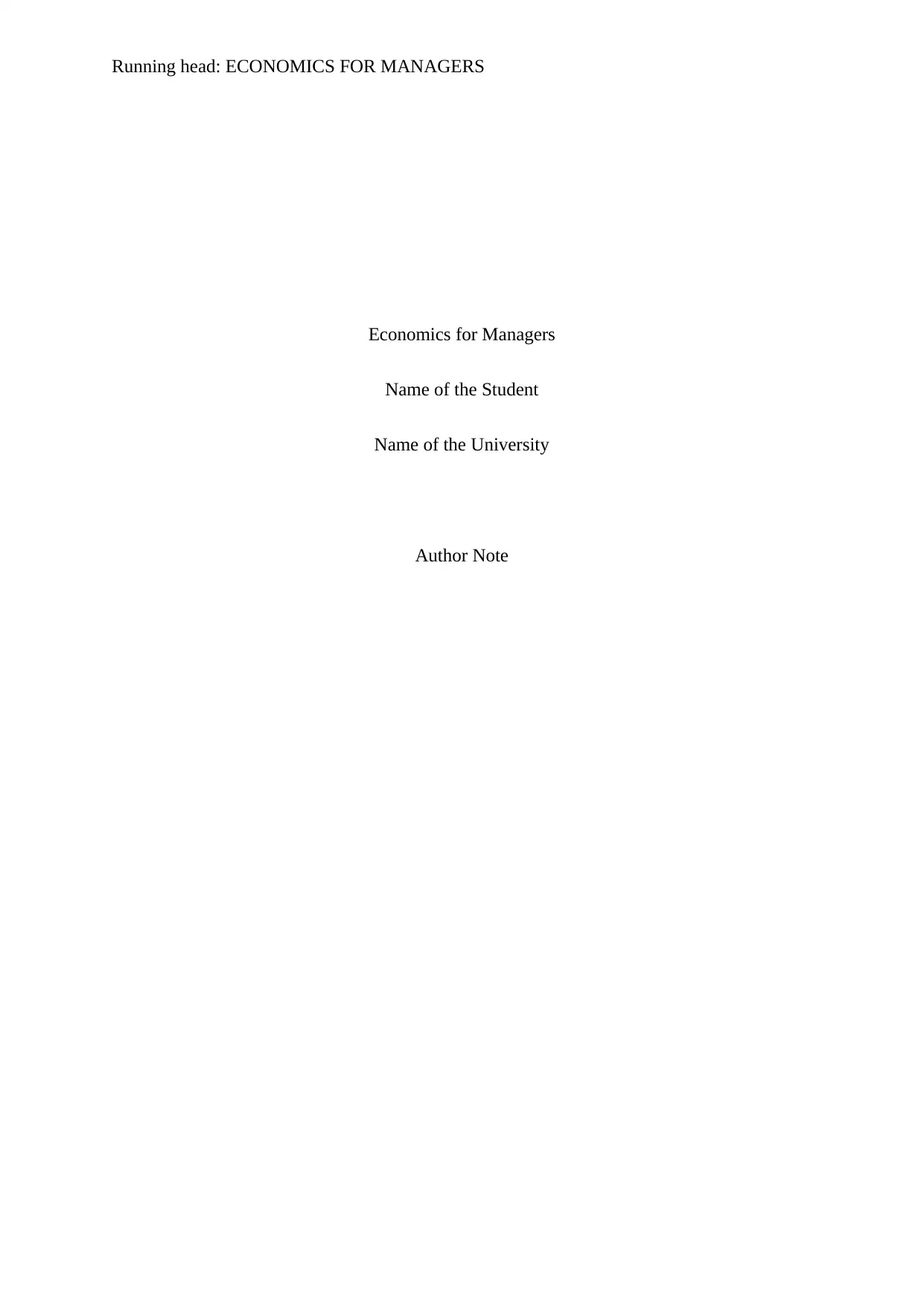
Running head: ECONOMICS FOR MANAGERS
Economics for Managers
Name of the Student
Name of the University
Author Note
Economics for Managers
Name of the Student
Name of the University
Author Note
Paraphrase This Document
Need a fresh take? Get an instant paraphrase of this document with our AI Paraphraser
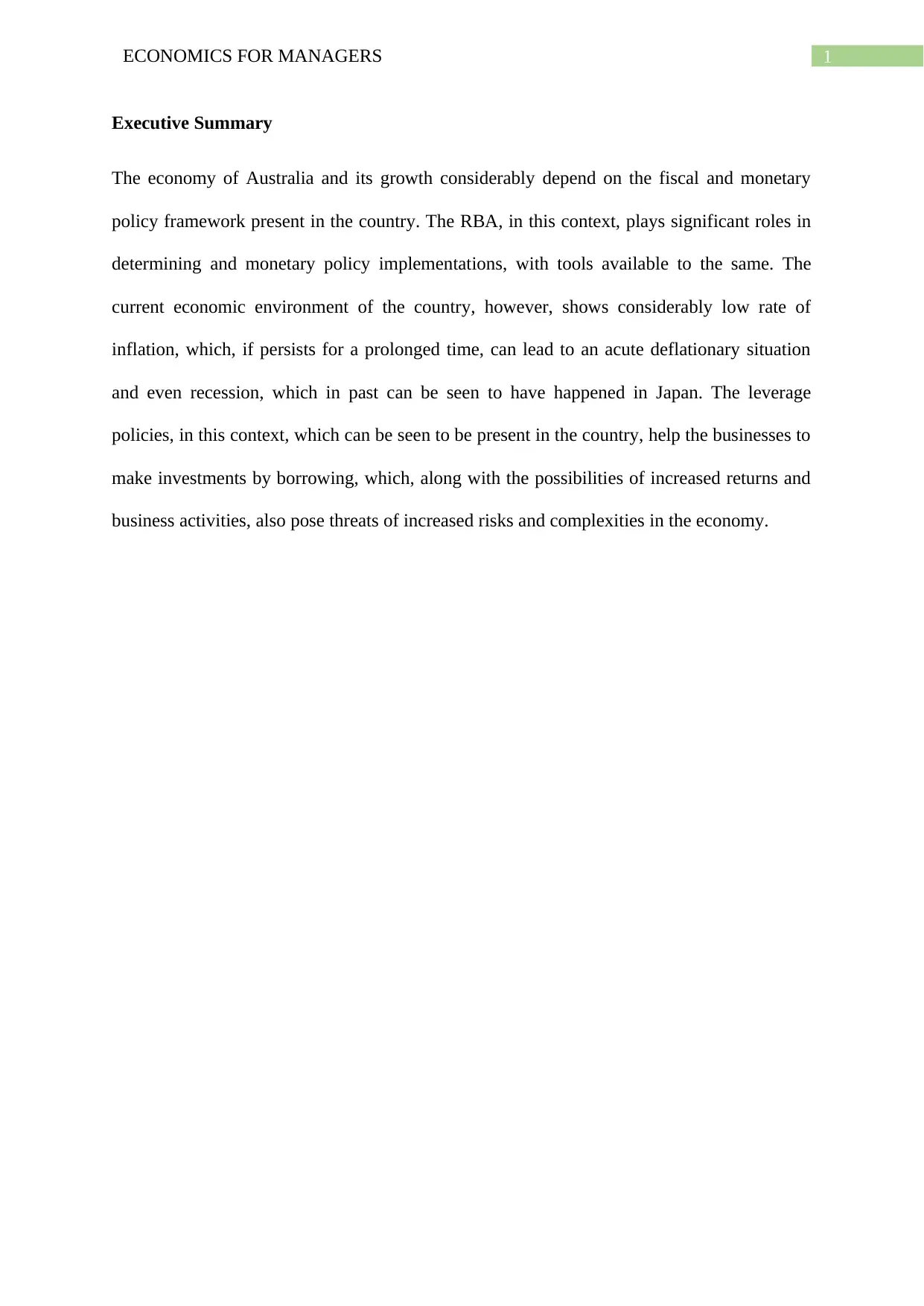
1ECONOMICS FOR MANAGERS
Executive Summary
The economy of Australia and its growth considerably depend on the fiscal and monetary
policy framework present in the country. The RBA, in this context, plays significant roles in
determining and monetary policy implementations, with tools available to the same. The
current economic environment of the country, however, shows considerably low rate of
inflation, which, if persists for a prolonged time, can lead to an acute deflationary situation
and even recession, which in past can be seen to have happened in Japan. The leverage
policies, in this context, which can be seen to be present in the country, help the businesses to
make investments by borrowing, which, along with the possibilities of increased returns and
business activities, also pose threats of increased risks and complexities in the economy.
Executive Summary
The economy of Australia and its growth considerably depend on the fiscal and monetary
policy framework present in the country. The RBA, in this context, plays significant roles in
determining and monetary policy implementations, with tools available to the same. The
current economic environment of the country, however, shows considerably low rate of
inflation, which, if persists for a prolonged time, can lead to an acute deflationary situation
and even recession, which in past can be seen to have happened in Japan. The leverage
policies, in this context, which can be seen to be present in the country, help the businesses to
make investments by borrowing, which, along with the possibilities of increased returns and
business activities, also pose threats of increased risks and complexities in the economy.
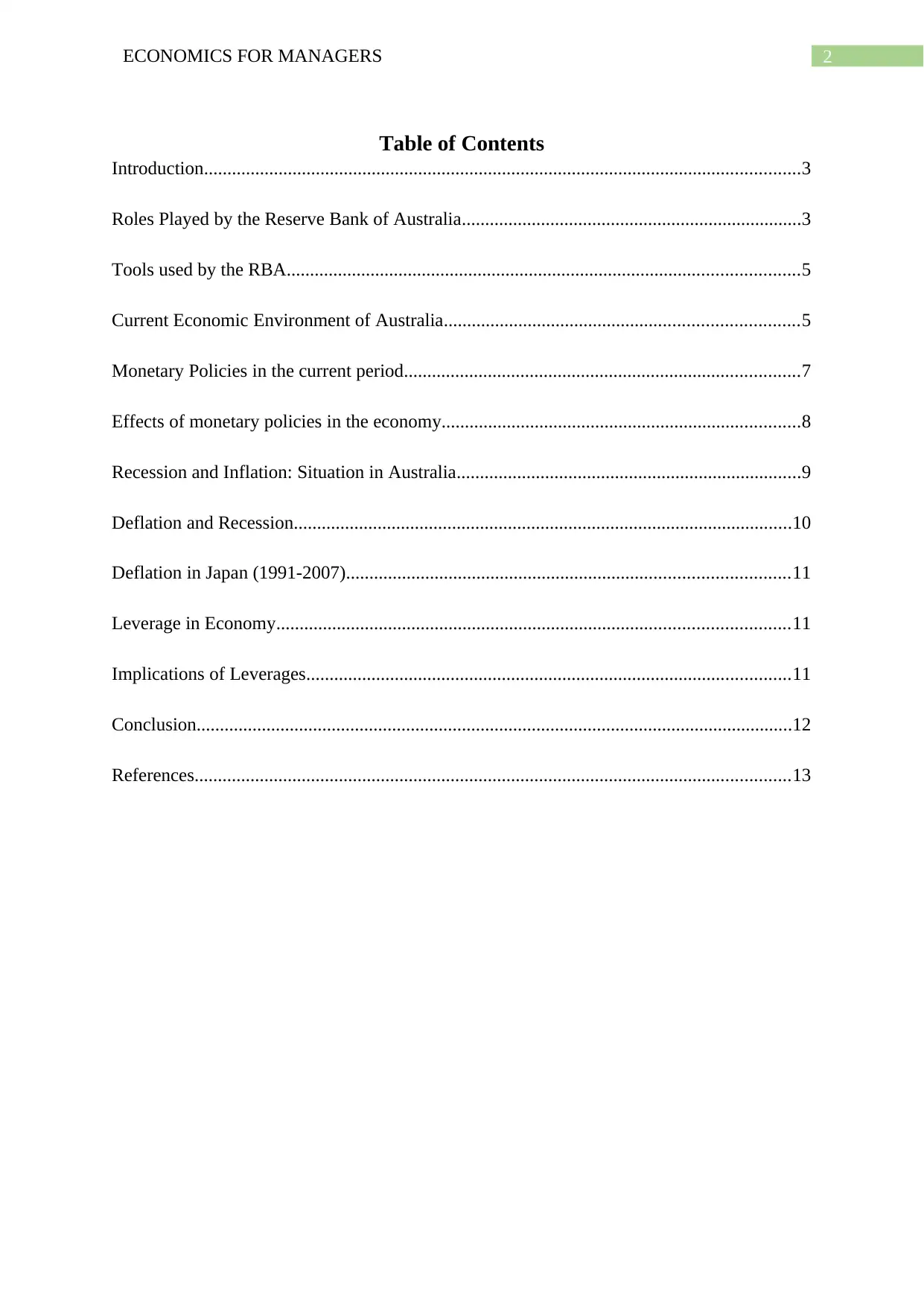
2ECONOMICS FOR MANAGERS
Table of Contents
Introduction................................................................................................................................3
Roles Played by the Reserve Bank of Australia.........................................................................3
Tools used by the RBA..............................................................................................................5
Current Economic Environment of Australia............................................................................5
Monetary Policies in the current period.....................................................................................7
Effects of monetary policies in the economy.............................................................................8
Recession and Inflation: Situation in Australia..........................................................................9
Deflation and Recession...........................................................................................................10
Deflation in Japan (1991-2007)...............................................................................................11
Leverage in Economy..............................................................................................................11
Implications of Leverages........................................................................................................11
Conclusion................................................................................................................................12
References................................................................................................................................13
Table of Contents
Introduction................................................................................................................................3
Roles Played by the Reserve Bank of Australia.........................................................................3
Tools used by the RBA..............................................................................................................5
Current Economic Environment of Australia............................................................................5
Monetary Policies in the current period.....................................................................................7
Effects of monetary policies in the economy.............................................................................8
Recession and Inflation: Situation in Australia..........................................................................9
Deflation and Recession...........................................................................................................10
Deflation in Japan (1991-2007)...............................................................................................11
Leverage in Economy..............................................................................................................11
Implications of Leverages........................................................................................................11
Conclusion................................................................................................................................12
References................................................................................................................................13
⊘ This is a preview!⊘
Do you want full access?
Subscribe today to unlock all pages.

Trusted by 1+ million students worldwide
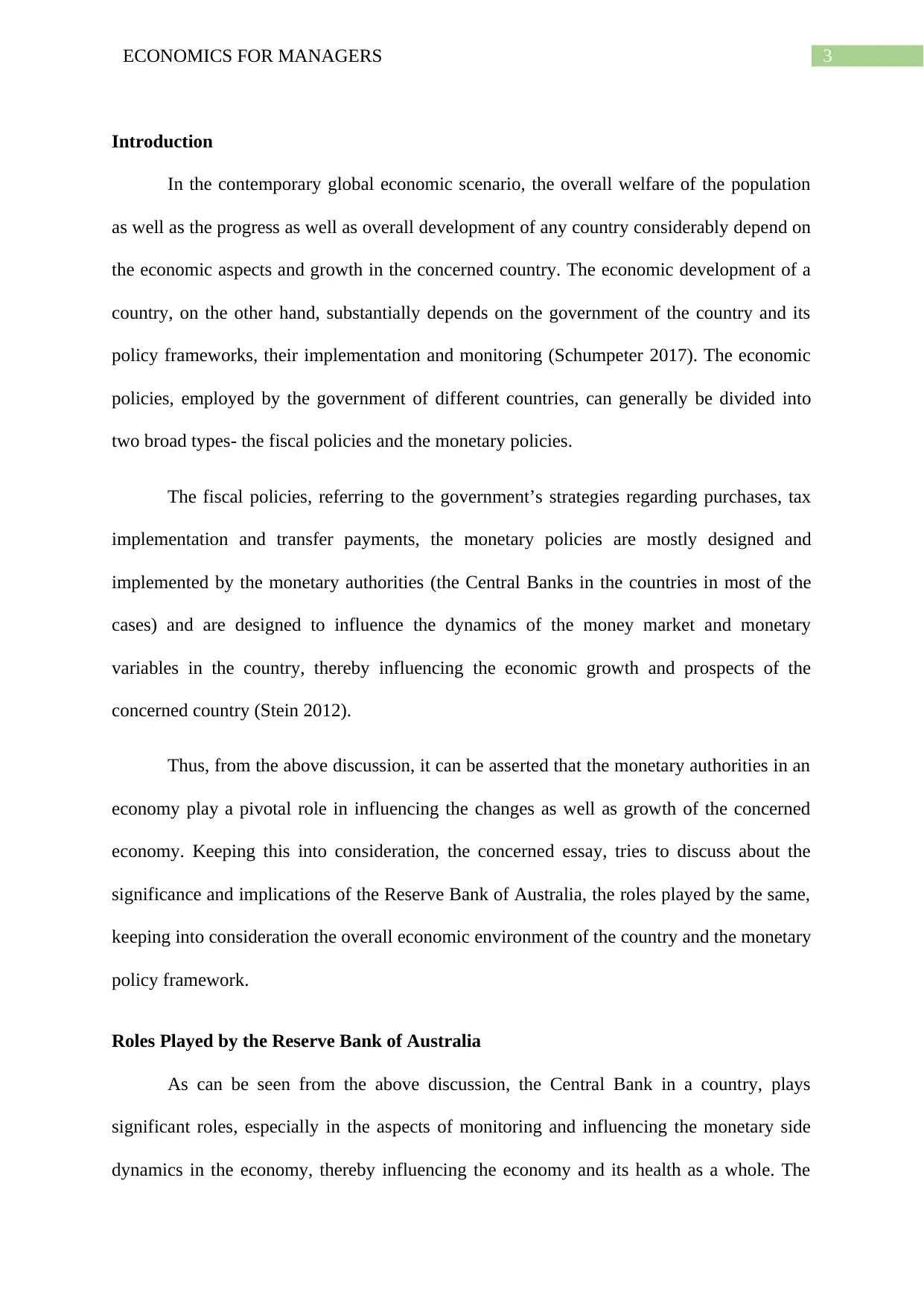
3ECONOMICS FOR MANAGERS
Introduction
In the contemporary global economic scenario, the overall welfare of the population
as well as the progress as well as overall development of any country considerably depend on
the economic aspects and growth in the concerned country. The economic development of a
country, on the other hand, substantially depends on the government of the country and its
policy frameworks, their implementation and monitoring (Schumpeter 2017). The economic
policies, employed by the government of different countries, can generally be divided into
two broad types- the fiscal policies and the monetary policies.
The fiscal policies, referring to the government’s strategies regarding purchases, tax
implementation and transfer payments, the monetary policies are mostly designed and
implemented by the monetary authorities (the Central Banks in the countries in most of the
cases) and are designed to influence the dynamics of the money market and monetary
variables in the country, thereby influencing the economic growth and prospects of the
concerned country (Stein 2012).
Thus, from the above discussion, it can be asserted that the monetary authorities in an
economy play a pivotal role in influencing the changes as well as growth of the concerned
economy. Keeping this into consideration, the concerned essay, tries to discuss about the
significance and implications of the Reserve Bank of Australia, the roles played by the same,
keeping into consideration the overall economic environment of the country and the monetary
policy framework.
Roles Played by the Reserve Bank of Australia
As can be seen from the above discussion, the Central Bank in a country, plays
significant roles, especially in the aspects of monitoring and influencing the monetary side
dynamics in the economy, thereby influencing the economy and its health as a whole. The
Introduction
In the contemporary global economic scenario, the overall welfare of the population
as well as the progress as well as overall development of any country considerably depend on
the economic aspects and growth in the concerned country. The economic development of a
country, on the other hand, substantially depends on the government of the country and its
policy frameworks, their implementation and monitoring (Schumpeter 2017). The economic
policies, employed by the government of different countries, can generally be divided into
two broad types- the fiscal policies and the monetary policies.
The fiscal policies, referring to the government’s strategies regarding purchases, tax
implementation and transfer payments, the monetary policies are mostly designed and
implemented by the monetary authorities (the Central Banks in the countries in most of the
cases) and are designed to influence the dynamics of the money market and monetary
variables in the country, thereby influencing the economic growth and prospects of the
concerned country (Stein 2012).
Thus, from the above discussion, it can be asserted that the monetary authorities in an
economy play a pivotal role in influencing the changes as well as growth of the concerned
economy. Keeping this into consideration, the concerned essay, tries to discuss about the
significance and implications of the Reserve Bank of Australia, the roles played by the same,
keeping into consideration the overall economic environment of the country and the monetary
policy framework.
Roles Played by the Reserve Bank of Australia
As can be seen from the above discussion, the Central Bank in a country, plays
significant roles, especially in the aspects of monitoring and influencing the monetary side
dynamics in the economy, thereby influencing the economy and its health as a whole. The
Paraphrase This Document
Need a fresh take? Get an instant paraphrase of this document with our AI Paraphraser
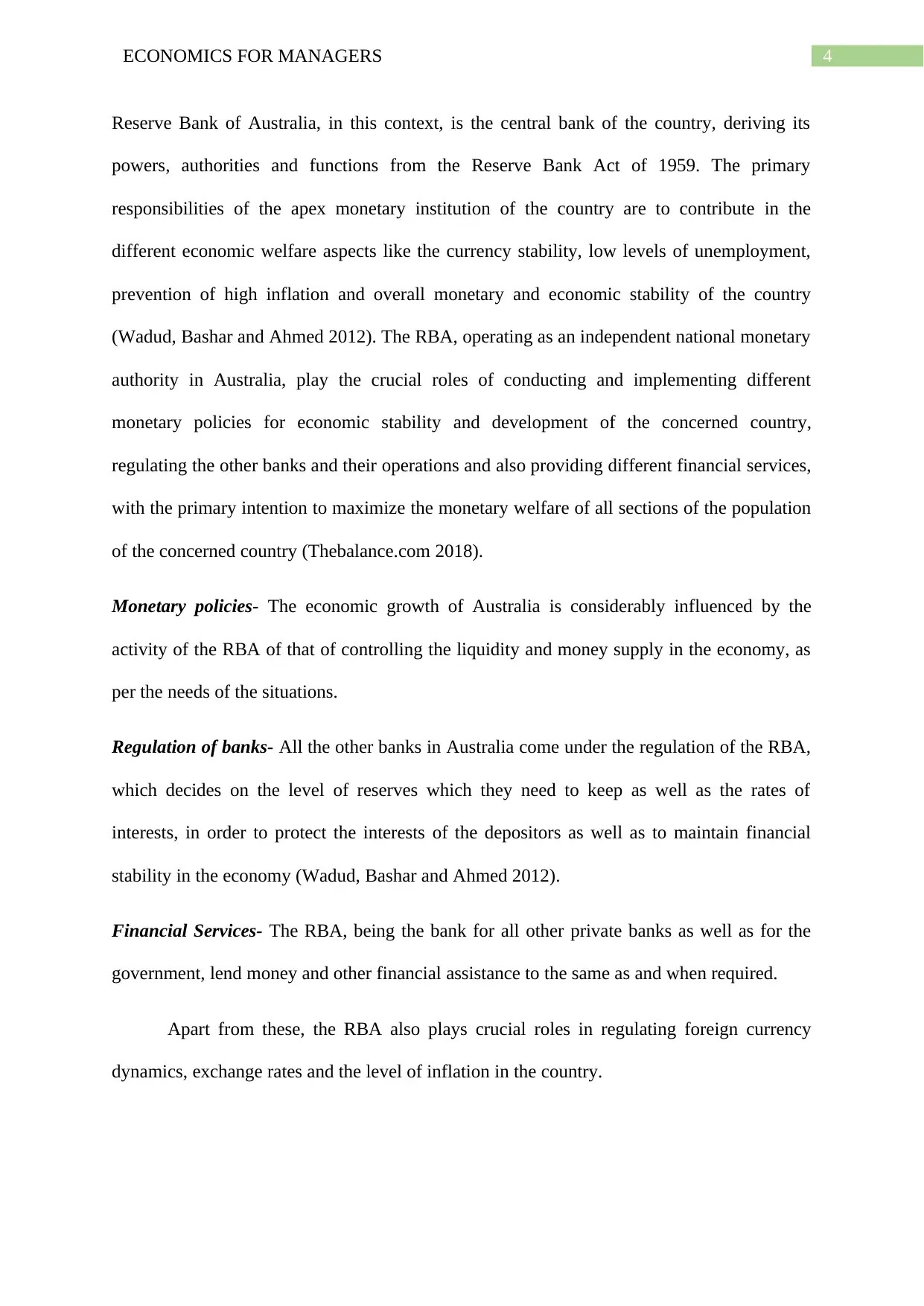
4ECONOMICS FOR MANAGERS
Reserve Bank of Australia, in this context, is the central bank of the country, deriving its
powers, authorities and functions from the Reserve Bank Act of 1959. The primary
responsibilities of the apex monetary institution of the country are to contribute in the
different economic welfare aspects like the currency stability, low levels of unemployment,
prevention of high inflation and overall monetary and economic stability of the country
(Wadud, Bashar and Ahmed 2012). The RBA, operating as an independent national monetary
authority in Australia, play the crucial roles of conducting and implementing different
monetary policies for economic stability and development of the concerned country,
regulating the other banks and their operations and also providing different financial services,
with the primary intention to maximize the monetary welfare of all sections of the population
of the concerned country (Thebalance.com 2018).
Monetary policies- The economic growth of Australia is considerably influenced by the
activity of the RBA of that of controlling the liquidity and money supply in the economy, as
per the needs of the situations.
Regulation of banks- All the other banks in Australia come under the regulation of the RBA,
which decides on the level of reserves which they need to keep as well as the rates of
interests, in order to protect the interests of the depositors as well as to maintain financial
stability in the economy (Wadud, Bashar and Ahmed 2012).
Financial Services- The RBA, being the bank for all other private banks as well as for the
government, lend money and other financial assistance to the same as and when required.
Apart from these, the RBA also plays crucial roles in regulating foreign currency
dynamics, exchange rates and the level of inflation in the country.
Reserve Bank of Australia, in this context, is the central bank of the country, deriving its
powers, authorities and functions from the Reserve Bank Act of 1959. The primary
responsibilities of the apex monetary institution of the country are to contribute in the
different economic welfare aspects like the currency stability, low levels of unemployment,
prevention of high inflation and overall monetary and economic stability of the country
(Wadud, Bashar and Ahmed 2012). The RBA, operating as an independent national monetary
authority in Australia, play the crucial roles of conducting and implementing different
monetary policies for economic stability and development of the concerned country,
regulating the other banks and their operations and also providing different financial services,
with the primary intention to maximize the monetary welfare of all sections of the population
of the concerned country (Thebalance.com 2018).
Monetary policies- The economic growth of Australia is considerably influenced by the
activity of the RBA of that of controlling the liquidity and money supply in the economy, as
per the needs of the situations.
Regulation of banks- All the other banks in Australia come under the regulation of the RBA,
which decides on the level of reserves which they need to keep as well as the rates of
interests, in order to protect the interests of the depositors as well as to maintain financial
stability in the economy (Wadud, Bashar and Ahmed 2012).
Financial Services- The RBA, being the bank for all other private banks as well as for the
government, lend money and other financial assistance to the same as and when required.
Apart from these, the RBA also plays crucial roles in regulating foreign currency
dynamics, exchange rates and the level of inflation in the country.
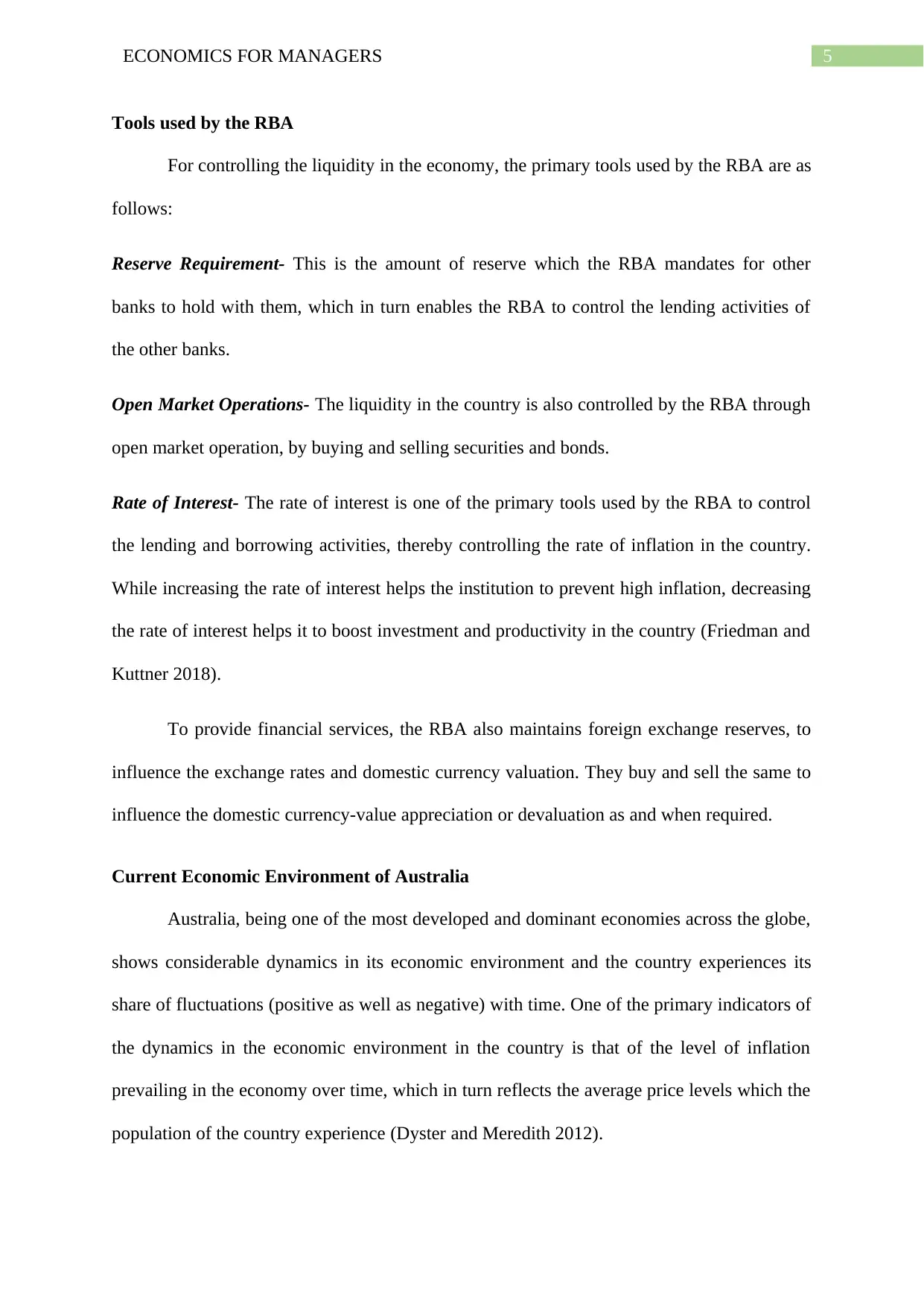
5ECONOMICS FOR MANAGERS
Tools used by the RBA
For controlling the liquidity in the economy, the primary tools used by the RBA are as
follows:
Reserve Requirement- This is the amount of reserve which the RBA mandates for other
banks to hold with them, which in turn enables the RBA to control the lending activities of
the other banks.
Open Market Operations- The liquidity in the country is also controlled by the RBA through
open market operation, by buying and selling securities and bonds.
Rate of Interest- The rate of interest is one of the primary tools used by the RBA to control
the lending and borrowing activities, thereby controlling the rate of inflation in the country.
While increasing the rate of interest helps the institution to prevent high inflation, decreasing
the rate of interest helps it to boost investment and productivity in the country (Friedman and
Kuttner 2018).
To provide financial services, the RBA also maintains foreign exchange reserves, to
influence the exchange rates and domestic currency valuation. They buy and sell the same to
influence the domestic currency-value appreciation or devaluation as and when required.
Current Economic Environment of Australia
Australia, being one of the most developed and dominant economies across the globe,
shows considerable dynamics in its economic environment and the country experiences its
share of fluctuations (positive as well as negative) with time. One of the primary indicators of
the dynamics in the economic environment in the country is that of the level of inflation
prevailing in the economy over time, which in turn reflects the average price levels which the
population of the country experience (Dyster and Meredith 2012).
Tools used by the RBA
For controlling the liquidity in the economy, the primary tools used by the RBA are as
follows:
Reserve Requirement- This is the amount of reserve which the RBA mandates for other
banks to hold with them, which in turn enables the RBA to control the lending activities of
the other banks.
Open Market Operations- The liquidity in the country is also controlled by the RBA through
open market operation, by buying and selling securities and bonds.
Rate of Interest- The rate of interest is one of the primary tools used by the RBA to control
the lending and borrowing activities, thereby controlling the rate of inflation in the country.
While increasing the rate of interest helps the institution to prevent high inflation, decreasing
the rate of interest helps it to boost investment and productivity in the country (Friedman and
Kuttner 2018).
To provide financial services, the RBA also maintains foreign exchange reserves, to
influence the exchange rates and domestic currency valuation. They buy and sell the same to
influence the domestic currency-value appreciation or devaluation as and when required.
Current Economic Environment of Australia
Australia, being one of the most developed and dominant economies across the globe,
shows considerable dynamics in its economic environment and the country experiences its
share of fluctuations (positive as well as negative) with time. One of the primary indicators of
the dynamics in the economic environment in the country is that of the level of inflation
prevailing in the economy over time, which in turn reflects the average price levels which the
population of the country experience (Dyster and Meredith 2012).
⊘ This is a preview!⊘
Do you want full access?
Subscribe today to unlock all pages.

Trusted by 1+ million students worldwide
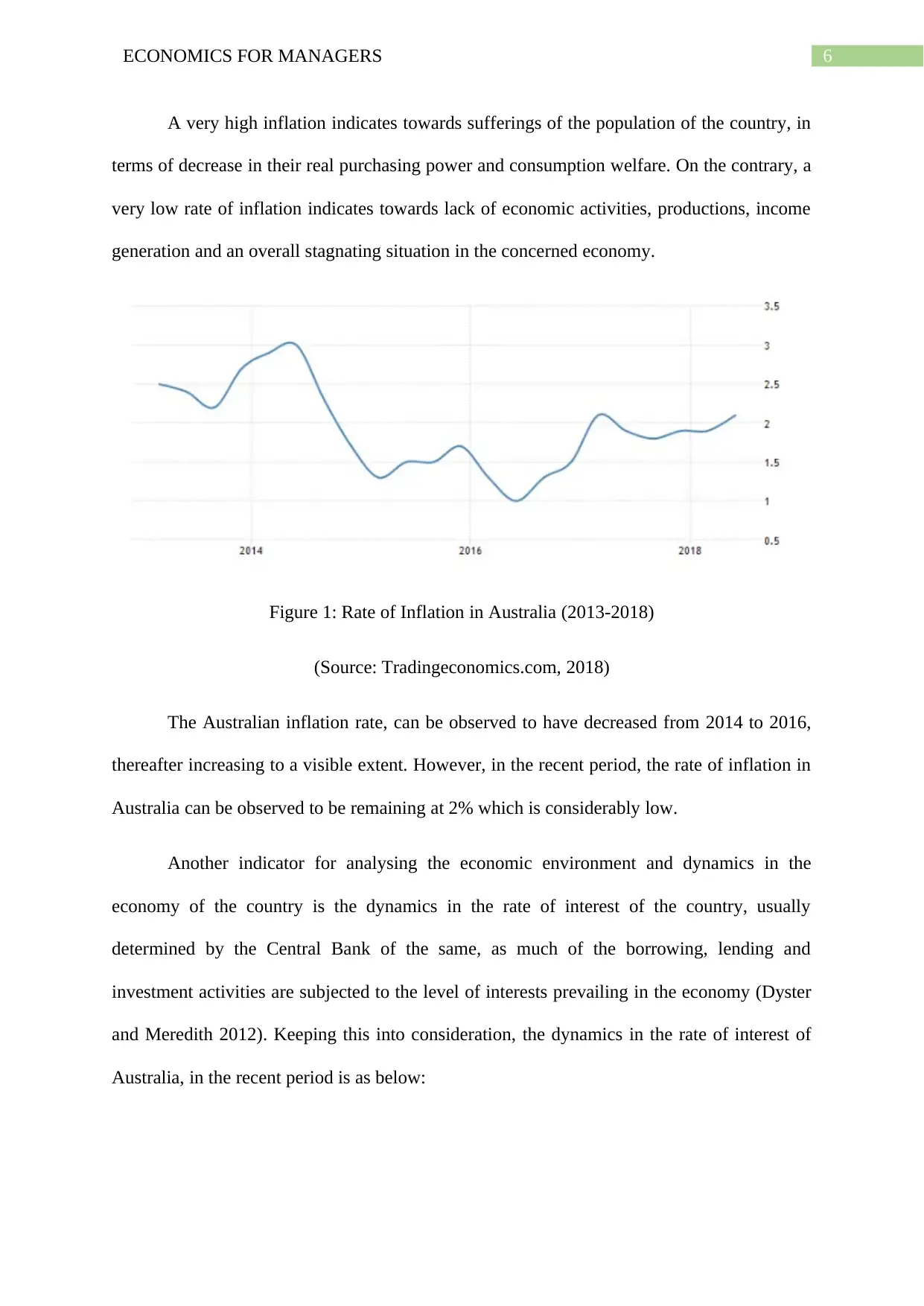
6ECONOMICS FOR MANAGERS
A very high inflation indicates towards sufferings of the population of the country, in
terms of decrease in their real purchasing power and consumption welfare. On the contrary, a
very low rate of inflation indicates towards lack of economic activities, productions, income
generation and an overall stagnating situation in the concerned economy.
Figure 1: Rate of Inflation in Australia (2013-2018)
(Source: Tradingeconomics.com, 2018)
The Australian inflation rate, can be observed to have decreased from 2014 to 2016,
thereafter increasing to a visible extent. However, in the recent period, the rate of inflation in
Australia can be observed to be remaining at 2% which is considerably low.
Another indicator for analysing the economic environment and dynamics in the
economy of the country is the dynamics in the rate of interest of the country, usually
determined by the Central Bank of the same, as much of the borrowing, lending and
investment activities are subjected to the level of interests prevailing in the economy (Dyster
and Meredith 2012). Keeping this into consideration, the dynamics in the rate of interest of
Australia, in the recent period is as below:
A very high inflation indicates towards sufferings of the population of the country, in
terms of decrease in their real purchasing power and consumption welfare. On the contrary, a
very low rate of inflation indicates towards lack of economic activities, productions, income
generation and an overall stagnating situation in the concerned economy.
Figure 1: Rate of Inflation in Australia (2013-2018)
(Source: Tradingeconomics.com, 2018)
The Australian inflation rate, can be observed to have decreased from 2014 to 2016,
thereafter increasing to a visible extent. However, in the recent period, the rate of inflation in
Australia can be observed to be remaining at 2% which is considerably low.
Another indicator for analysing the economic environment and dynamics in the
economy of the country is the dynamics in the rate of interest of the country, usually
determined by the Central Bank of the same, as much of the borrowing, lending and
investment activities are subjected to the level of interests prevailing in the economy (Dyster
and Meredith 2012). Keeping this into consideration, the dynamics in the rate of interest of
Australia, in the recent period is as below:
Paraphrase This Document
Need a fresh take? Get an instant paraphrase of this document with our AI Paraphraser
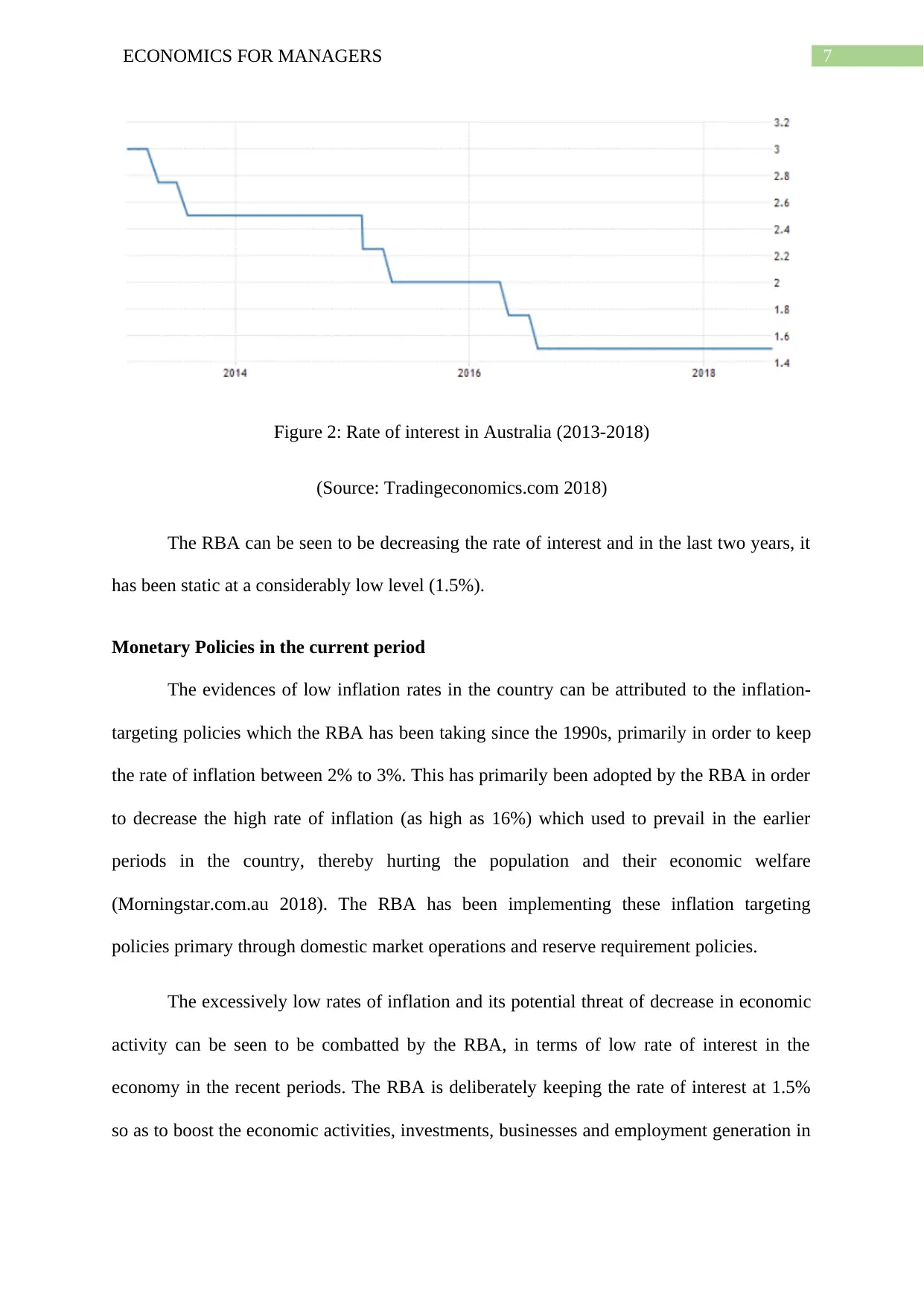
7ECONOMICS FOR MANAGERS
Figure 2: Rate of interest in Australia (2013-2018)
(Source: Tradingeconomics.com 2018)
The RBA can be seen to be decreasing the rate of interest and in the last two years, it
has been static at a considerably low level (1.5%).
Monetary Policies in the current period
The evidences of low inflation rates in the country can be attributed to the inflation-
targeting policies which the RBA has been taking since the 1990s, primarily in order to keep
the rate of inflation between 2% to 3%. This has primarily been adopted by the RBA in order
to decrease the high rate of inflation (as high as 16%) which used to prevail in the earlier
periods in the country, thereby hurting the population and their economic welfare
(Morningstar.com.au 2018). The RBA has been implementing these inflation targeting
policies primary through domestic market operations and reserve requirement policies.
The excessively low rates of inflation and its potential threat of decrease in economic
activity can be seen to be combatted by the RBA, in terms of low rate of interest in the
economy in the recent periods. The RBA is deliberately keeping the rate of interest at 1.5%
so as to boost the economic activities, investments, businesses and employment generation in
Figure 2: Rate of interest in Australia (2013-2018)
(Source: Tradingeconomics.com 2018)
The RBA can be seen to be decreasing the rate of interest and in the last two years, it
has been static at a considerably low level (1.5%).
Monetary Policies in the current period
The evidences of low inflation rates in the country can be attributed to the inflation-
targeting policies which the RBA has been taking since the 1990s, primarily in order to keep
the rate of inflation between 2% to 3%. This has primarily been adopted by the RBA in order
to decrease the high rate of inflation (as high as 16%) which used to prevail in the earlier
periods in the country, thereby hurting the population and their economic welfare
(Morningstar.com.au 2018). The RBA has been implementing these inflation targeting
policies primary through domestic market operations and reserve requirement policies.
The excessively low rates of inflation and its potential threat of decrease in economic
activity can be seen to be combatted by the RBA, in terms of low rate of interest in the
economy in the recent periods. The RBA is deliberately keeping the rate of interest at 1.5%
so as to boost the economic activities, investments, businesses and employment generation in
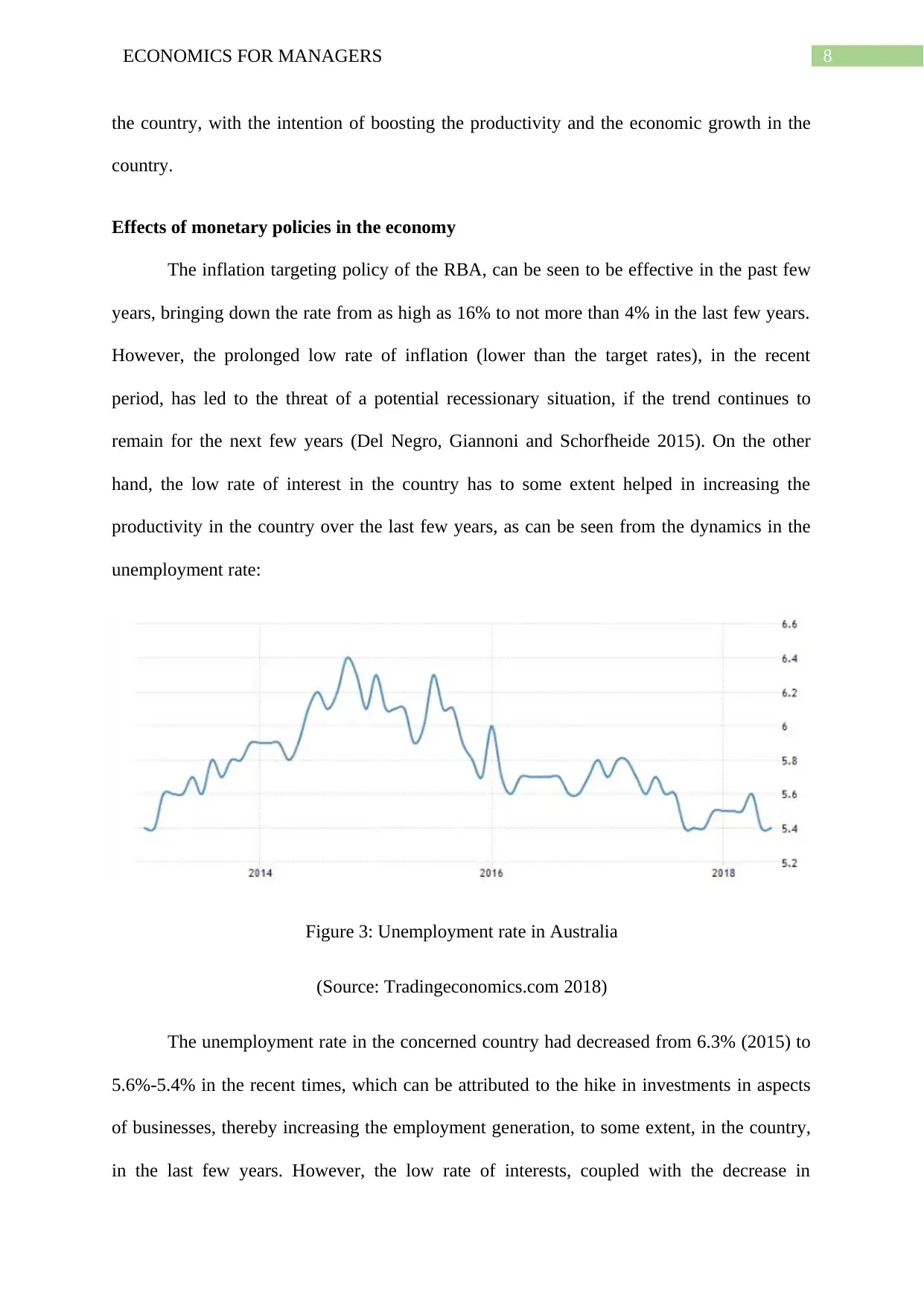
8ECONOMICS FOR MANAGERS
the country, with the intention of boosting the productivity and the economic growth in the
country.
Effects of monetary policies in the economy
The inflation targeting policy of the RBA, can be seen to be effective in the past few
years, bringing down the rate from as high as 16% to not more than 4% in the last few years.
However, the prolonged low rate of inflation (lower than the target rates), in the recent
period, has led to the threat of a potential recessionary situation, if the trend continues to
remain for the next few years (Del Negro, Giannoni and Schorfheide 2015). On the other
hand, the low rate of interest in the country has to some extent helped in increasing the
productivity in the country over the last few years, as can be seen from the dynamics in the
unemployment rate:
Figure 3: Unemployment rate in Australia
(Source: Tradingeconomics.com 2018)
The unemployment rate in the concerned country had decreased from 6.3% (2015) to
5.6%-5.4% in the recent times, which can be attributed to the hike in investments in aspects
of businesses, thereby increasing the employment generation, to some extent, in the country,
in the last few years. However, the low rate of interests, coupled with the decrease in
the country, with the intention of boosting the productivity and the economic growth in the
country.
Effects of monetary policies in the economy
The inflation targeting policy of the RBA, can be seen to be effective in the past few
years, bringing down the rate from as high as 16% to not more than 4% in the last few years.
However, the prolonged low rate of inflation (lower than the target rates), in the recent
period, has led to the threat of a potential recessionary situation, if the trend continues to
remain for the next few years (Del Negro, Giannoni and Schorfheide 2015). On the other
hand, the low rate of interest in the country has to some extent helped in increasing the
productivity in the country over the last few years, as can be seen from the dynamics in the
unemployment rate:
Figure 3: Unemployment rate in Australia
(Source: Tradingeconomics.com 2018)
The unemployment rate in the concerned country had decreased from 6.3% (2015) to
5.6%-5.4% in the recent times, which can be attributed to the hike in investments in aspects
of businesses, thereby increasing the employment generation, to some extent, in the country,
in the last few years. However, the low rate of interests, coupled with the decrease in
⊘ This is a preview!⊘
Do you want full access?
Subscribe today to unlock all pages.

Trusted by 1+ million students worldwide
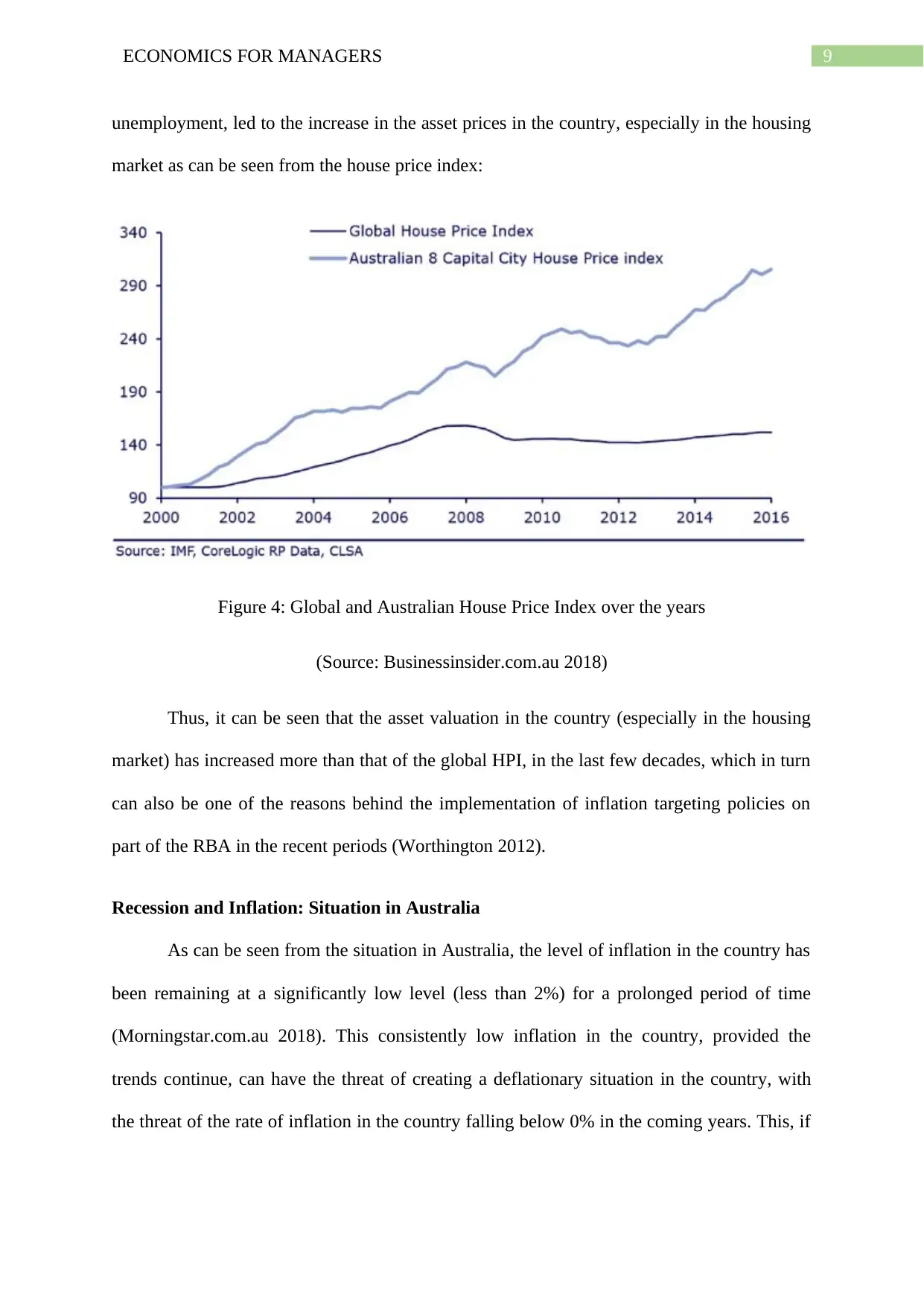
9ECONOMICS FOR MANAGERS
unemployment, led to the increase in the asset prices in the country, especially in the housing
market as can be seen from the house price index:
Figure 4: Global and Australian House Price Index over the years
(Source: Businessinsider.com.au 2018)
Thus, it can be seen that the asset valuation in the country (especially in the housing
market) has increased more than that of the global HPI, in the last few decades, which in turn
can also be one of the reasons behind the implementation of inflation targeting policies on
part of the RBA in the recent periods (Worthington 2012).
Recession and Inflation: Situation in Australia
As can be seen from the situation in Australia, the level of inflation in the country has
been remaining at a significantly low level (less than 2%) for a prolonged period of time
(Morningstar.com.au 2018). This consistently low inflation in the country, provided the
trends continue, can have the threat of creating a deflationary situation in the country, with
the threat of the rate of inflation in the country falling below 0% in the coming years. This, if
unemployment, led to the increase in the asset prices in the country, especially in the housing
market as can be seen from the house price index:
Figure 4: Global and Australian House Price Index over the years
(Source: Businessinsider.com.au 2018)
Thus, it can be seen that the asset valuation in the country (especially in the housing
market) has increased more than that of the global HPI, in the last few decades, which in turn
can also be one of the reasons behind the implementation of inflation targeting policies on
part of the RBA in the recent periods (Worthington 2012).
Recession and Inflation: Situation in Australia
As can be seen from the situation in Australia, the level of inflation in the country has
been remaining at a significantly low level (less than 2%) for a prolonged period of time
(Morningstar.com.au 2018). This consistently low inflation in the country, provided the
trends continue, can have the threat of creating a deflationary situation in the country, with
the threat of the rate of inflation in the country falling below 0% in the coming years. This, if
Paraphrase This Document
Need a fresh take? Get an instant paraphrase of this document with our AI Paraphraser
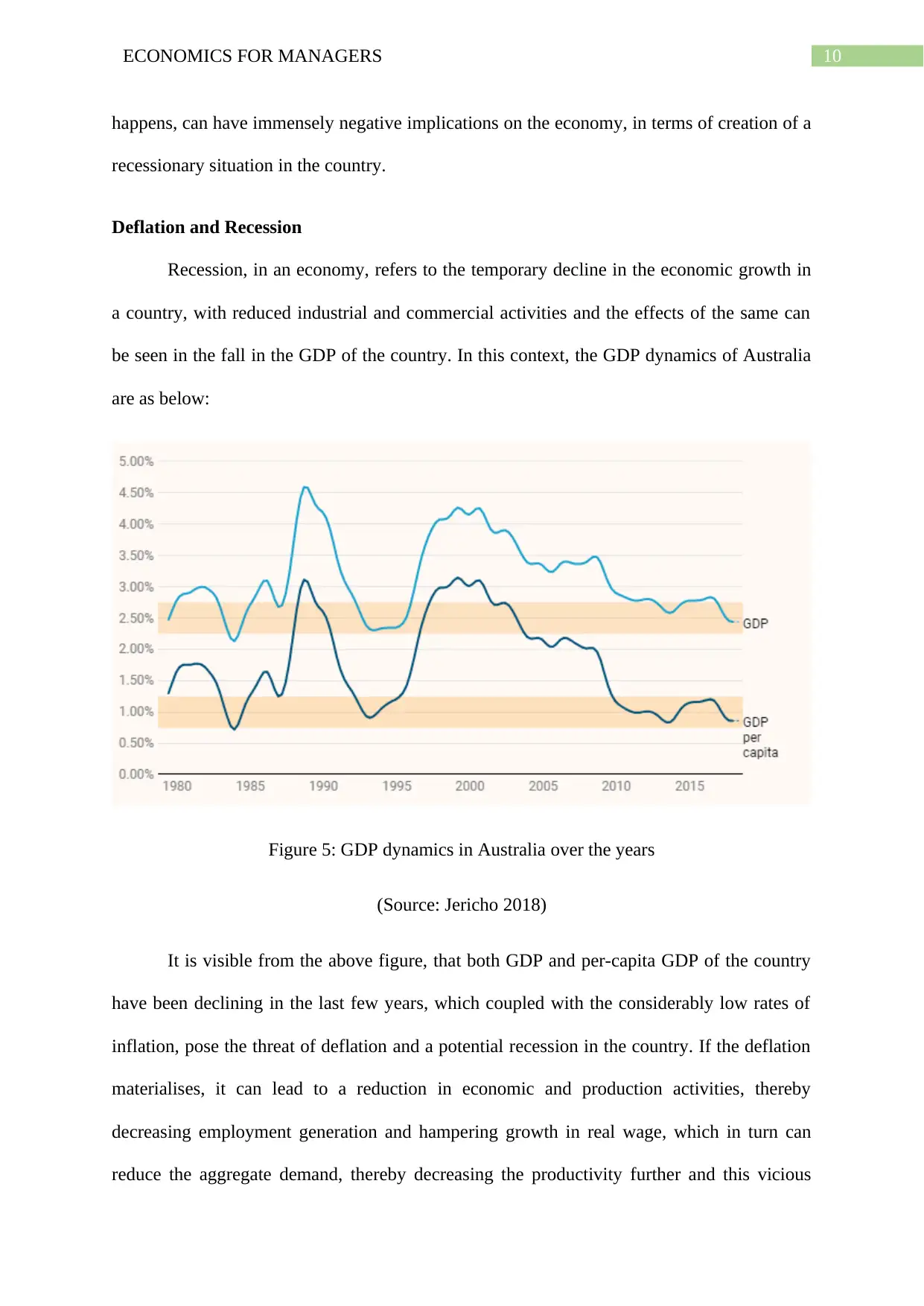
10ECONOMICS FOR MANAGERS
happens, can have immensely negative implications on the economy, in terms of creation of a
recessionary situation in the country.
Deflation and Recession
Recession, in an economy, refers to the temporary decline in the economic growth in
a country, with reduced industrial and commercial activities and the effects of the same can
be seen in the fall in the GDP of the country. In this context, the GDP dynamics of Australia
are as below:
Figure 5: GDP dynamics in Australia over the years
(Source: Jericho 2018)
It is visible from the above figure, that both GDP and per-capita GDP of the country
have been declining in the last few years, which coupled with the considerably low rates of
inflation, pose the threat of deflation and a potential recession in the country. If the deflation
materialises, it can lead to a reduction in economic and production activities, thereby
decreasing employment generation and hampering growth in real wage, which in turn can
reduce the aggregate demand, thereby decreasing the productivity further and this vicious
happens, can have immensely negative implications on the economy, in terms of creation of a
recessionary situation in the country.
Deflation and Recession
Recession, in an economy, refers to the temporary decline in the economic growth in
a country, with reduced industrial and commercial activities and the effects of the same can
be seen in the fall in the GDP of the country. In this context, the GDP dynamics of Australia
are as below:
Figure 5: GDP dynamics in Australia over the years
(Source: Jericho 2018)
It is visible from the above figure, that both GDP and per-capita GDP of the country
have been declining in the last few years, which coupled with the considerably low rates of
inflation, pose the threat of deflation and a potential recession in the country. If the deflation
materialises, it can lead to a reduction in economic and production activities, thereby
decreasing employment generation and hampering growth in real wage, which in turn can
reduce the aggregate demand, thereby decreasing the productivity further and this vicious
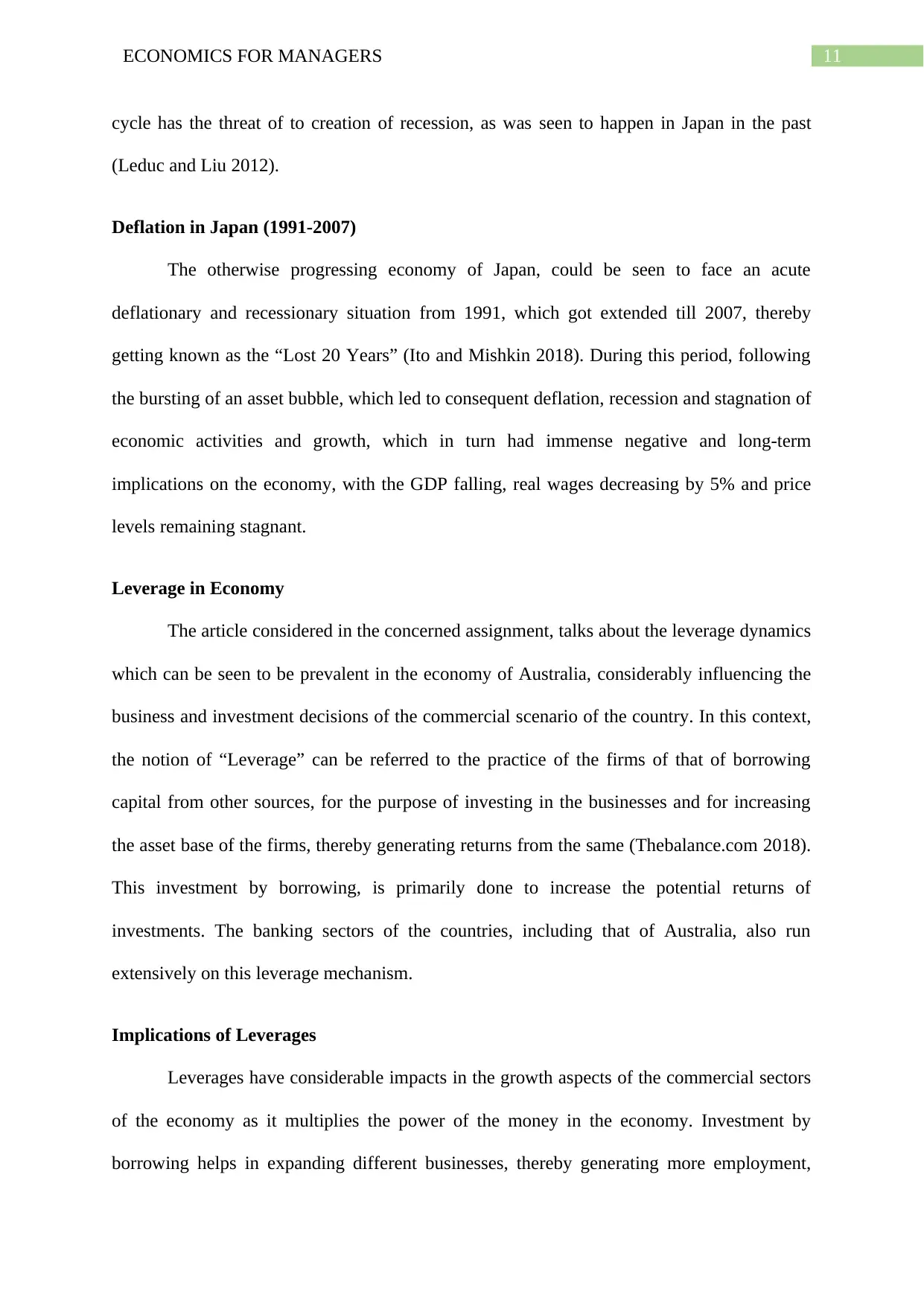
11ECONOMICS FOR MANAGERS
cycle has the threat of to creation of recession, as was seen to happen in Japan in the past
(Leduc and Liu 2012).
Deflation in Japan (1991-2007)
The otherwise progressing economy of Japan, could be seen to face an acute
deflationary and recessionary situation from 1991, which got extended till 2007, thereby
getting known as the “Lost 20 Years” (Ito and Mishkin 2018). During this period, following
the bursting of an asset bubble, which led to consequent deflation, recession and stagnation of
economic activities and growth, which in turn had immense negative and long-term
implications on the economy, with the GDP falling, real wages decreasing by 5% and price
levels remaining stagnant.
Leverage in Economy
The article considered in the concerned assignment, talks about the leverage dynamics
which can be seen to be prevalent in the economy of Australia, considerably influencing the
business and investment decisions of the commercial scenario of the country. In this context,
the notion of “Leverage” can be referred to the practice of the firms of that of borrowing
capital from other sources, for the purpose of investing in the businesses and for increasing
the asset base of the firms, thereby generating returns from the same (Thebalance.com 2018).
This investment by borrowing, is primarily done to increase the potential returns of
investments. The banking sectors of the countries, including that of Australia, also run
extensively on this leverage mechanism.
Implications of Leverages
Leverages have considerable impacts in the growth aspects of the commercial sectors
of the economy as it multiplies the power of the money in the economy. Investment by
borrowing helps in expanding different businesses, thereby generating more employment,
cycle has the threat of to creation of recession, as was seen to happen in Japan in the past
(Leduc and Liu 2012).
Deflation in Japan (1991-2007)
The otherwise progressing economy of Japan, could be seen to face an acute
deflationary and recessionary situation from 1991, which got extended till 2007, thereby
getting known as the “Lost 20 Years” (Ito and Mishkin 2018). During this period, following
the bursting of an asset bubble, which led to consequent deflation, recession and stagnation of
economic activities and growth, which in turn had immense negative and long-term
implications on the economy, with the GDP falling, real wages decreasing by 5% and price
levels remaining stagnant.
Leverage in Economy
The article considered in the concerned assignment, talks about the leverage dynamics
which can be seen to be prevalent in the economy of Australia, considerably influencing the
business and investment decisions of the commercial scenario of the country. In this context,
the notion of “Leverage” can be referred to the practice of the firms of that of borrowing
capital from other sources, for the purpose of investing in the businesses and for increasing
the asset base of the firms, thereby generating returns from the same (Thebalance.com 2018).
This investment by borrowing, is primarily done to increase the potential returns of
investments. The banking sectors of the countries, including that of Australia, also run
extensively on this leverage mechanism.
Implications of Leverages
Leverages have considerable impacts in the growth aspects of the commercial sectors
of the economy as it multiplies the power of the money in the economy. Investment by
borrowing helps in expanding different businesses, thereby generating more employment,
⊘ This is a preview!⊘
Do you want full access?
Subscribe today to unlock all pages.

Trusted by 1+ million students worldwide
1 out of 16
Related Documents
Your All-in-One AI-Powered Toolkit for Academic Success.
+13062052269
info@desklib.com
Available 24*7 on WhatsApp / Email
![[object Object]](/_next/static/media/star-bottom.7253800d.svg)
Unlock your academic potential
Copyright © 2020–2025 A2Z Services. All Rights Reserved. Developed and managed by ZUCOL.





